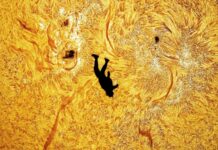A 4,000-year-old silver goblet discovered in the Judean Hills may depict an earlier, more universal creation story than previously believed. For decades, scholars assumed the intricate imagery on the vessel, known as the ˁAin Samiya goblet, illustrated the Babylonian Enuma Elish myth—the epic tale of Marduk’s battle against chaos. However, a new study published in the Journal of the Ancient Near Eastern Society argues this interpretation is unlikely, given the timeline and the goblet’s unique artistic style.
The Goblet’s Discovery and Initial Theories
The ˁAin Samiya goblet—a rare find from the Intermediate Bronze Age (c. 2650–1950 BCE)—is one of the few surviving pieces of art from this period in the Levant. The vessel features two primary scenes. The first depicts a composite figure—part human, part animal—holding plants, with a rosette positioned between its legs. Two bull legs emerge from the figure’s lower body, and a large serpent stands nearby. The second scene shows two human figures holding a crescent containing a sun with a face. The serpent now lies subdued beneath the crescent.
Early scholars, including Yigael Yadin, proposed a connection to the Enuma Elish, suggesting the scenes represented Marduk’s victory over the sea goddess Tiamat. Yet, the goblet predates the emergence of the Enuma Elish by nearly a millennium, and its imagery lacks the violent struggle central to the myth.
A New Interpretation: Cosmic Ordering
The recent study proposes a different understanding: the goblet depicts the peaceful process of cosmic ordering, rather than a specific narrative. The first scene is interpreted as representing primordial chaos, while the second shows the establishment of structure and stability. The sun deity, initially small and nascent, grows to prominence, acquiring a fully formed face.
“The artist has effectively depicted the passage of time through simple stylistic choices,” the study authors explain. “On the left, the sun appears small, demonstrating its recent birth, while on the right, it radiates strength and happiness with its en face depiction.”
The deities themselves evolve: their skin smooths, their attire modernizes, and even subtle wrinkles appear on their necks, suggesting the passage of time. The serpent, once assertive, becomes subdued, its posture reflecting the triumph of order over chaos.
Regional Connections and Artistic Influences
The study draws parallels to other cosmological myths throughout the Near East, including Egyptian and Anatolian traditions. The crescent boat shape, used to transport celestial objects, appears in various cultures. Bull-human hybrids are also common in Near Eastern iconography.
The team suggests the goblet was created by an artist from southern Mesopotamia, likely produced in northern Mesopotamia or Syria, where silver was readily available. The iconography reflects a broader regional tradition, predating the specific narratives of later myths like the Enuma Elish.
Remaining Questions and Scholarly Debate
Despite the compelling arguments, uncertainty remains. The goblet’s original condition was poorly documented, and its interpretation relies on iconographic comparisons rather than textual evidence. Some scholars remain skeptical. Mark Smith, a Biblical scholar at Princeton Theological Seminary, suggests the imagery may represent other myths, such as the Baal cycle, rather than a creation myth at all.
The ˁAin Samiya goblet, while not a direct illustration of the Enuma Elish, offers a valuable glimpse into the early cosmological beliefs of the Near East. Its imagery reflects a broader tradition of ordering chaos, predating the specific narratives of later myths. This suggests that the goblet may depict a more universal, foundational story about the birth of the cosmos, rather than a localized myth




























